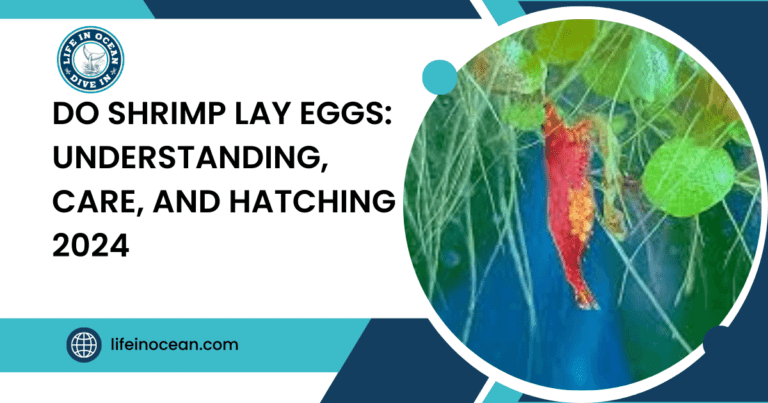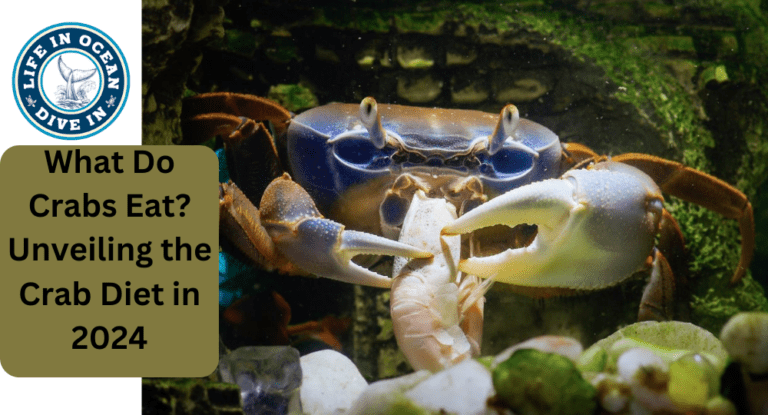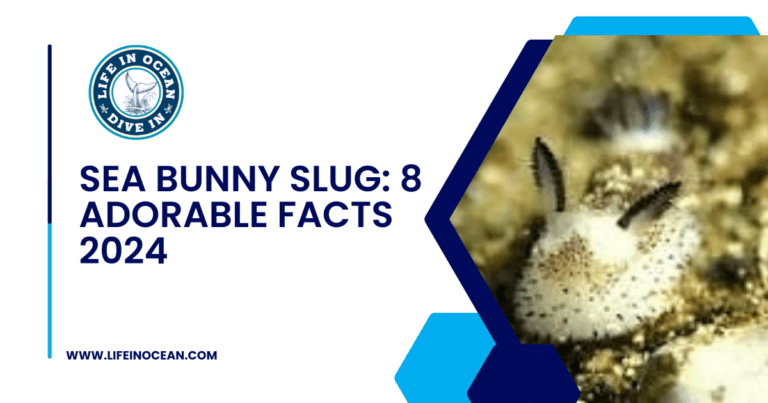Picture this: you’re snorkeling in the deep blue ocean, surrounded by a world teeming with life, including giant squid and giant Pacific octopus. They gracefully navigate the seas while you explore the vibrant seafloor. Suddenly, you come across two mesmerizing creatures – a squid, an octopus, and other different animals. These captivating creatures can be found in the seas, where they interact with small fish and live inside a shell. These fascinating creatures, such as the giant Pacific octopus and various squid species, belong to the class Cephalopoda. They are known for their intelligence and unique adaptations, including the giant squid that can be found on the ocean floor. But what sets them apart?
Squid and octopus may seem similar at first glance, but they have distinct characteristics that make them stand out from each other. On one side, squid have elongated bodies and a pair of fins on their head, while octopuses have rounded bodies and lack fins. One notable difference lies in their method of propulsion. While both squids and fish use jet propulsion to move through the water, squids are known for their incredible speed and agility, propelling themselves forward with bursts of water expelled from their bodies.
This allows them to swiftly maneuver through the water, using their side fins and head to change direction. On the other hand, octopuses rely on undulating movements of their arms to propel themselves gracefully using their head. Intrigued? Join us as we explore more captivating disparities between squids and octopuses and delve into the depths of these enigmatic sea dwellers.
Table of Contents
Habitat
Squid and octopuses are different because squid can live in many places while octopuses like specific spots. Squids can handle different water depths and temperatures, so they can be found in warm and cold seas. They can live near the coast or far from land. Octopuses like rocky crevices and coral reefs where they can hide from predators. Both squid and octopus are good at disguising themselves. Squid can change color to blend in, while octopuses can change color and texture to look like rocks or corals. Squid usually travel in groups for safety, but octopuses prefer to be alone.
Anatomy
The anatomy of squid and octopus plays a crucial role in their ability to navigate swiftly through the water. Let’s take a closer look at the distinct features of each creature.
Squid
Squid have a sleek body that helps them move fast. They have a mantle, fins, and a siphon. The mantle protects their organs and has their gills for breathing. The fins help them steer and move in the water. Squid can swim fast by using their siphon to shoot out water.
Octopus
Octopuses are different from squid because they don’t have a hard skeleton. This means they can squeeze into small spaces underwater. The common octopus has eight tentacles with suckers that it uses for catching food and moving around. When comparing squid vs octopus size, the giant squid size is significantly larger than that of the common octopus. The squid vs octopus difference lies in their size. Octopuses also have big brains, which makes them smart and good at solving problems..
A World Underwater
Squid and octopus are cool animals that live in the water. Squid have long bodies that help them swim fast in open water. Cephalopods, such as octopuses, have soft bodies and tentacles to move around on the ocean floor. Studying their bodies helps us understand how they’ve adapted to their underwater homes. Whether it’s squid swimming in the open ocean or octopuses crawling on the seabed, their special features help them survive and do well in the water.
Arms/Tentacles
Squid and octopus may seem similar, but They have some distinct differences. Let’s take a closer look at these fascinating appendages and how they contribute to the hunting strategies of these cephalopods.
Squid Arms: Tenacious Tentacles
Squid are equipped with ten arms in total, two of which are specialized tentacles. These tentacles are longer than the other arms and play a crucial role in capturing prey. They have a unique feature called “clubs” at the tips, which are covered in suckers armed with small teeth-like structures called “hooks.” When hunting, squid use their powerful muscular contractions to extend their tentacles rapidly towards their target, striking it with great force. The hooks on the suckers help them secure a firm grip on their prey, making it difficult for them to escape.
Octopus Arms: Suckers for Manipulation
Octopuses have eight arms with lots of suckers. These suckers help them do different things, like moving and grabbing stuff. Octopus arms can bend and move really well, so they can pick up things carefully. The suckers also have special cells that let the octopus feel and taste things around them. Octopuses can even use their suckers to move around. They can stick to surfaces like rocks or coral reefs by making suction with their suckers. By sticking and unsticking their suckers in a smart way, they can move easily on different surfaces.
Hunting Strategies: A Battle of Tactics
The different arm structures of squid and octopus reflect their distinct hunting strategies.
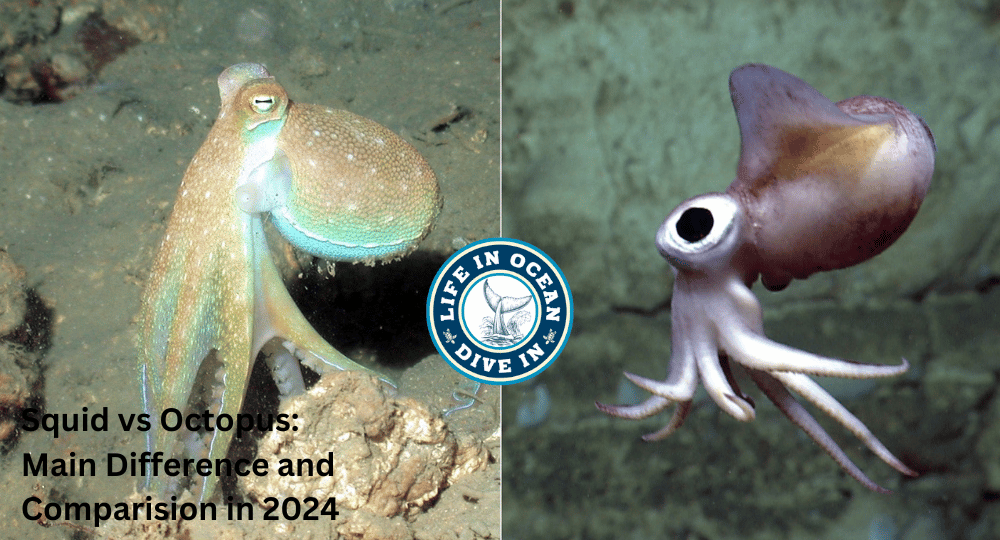
- Squid: With their longer tentacles armed with clubs and hooks, squids focus on capturing fast-moving prey like fish or crustaceans. They employ an ambush technique where they lie in wait before launching a swift attack using their specialized arms. Once the prey is caught, the squid’s tentacles bring it closer to its beak for consumption.
- Octopus: Octopuses, a type of squid, rely on their flexible arms and suckers for a more versatile hunting approach. They are known for their ability to squeeze into tight spaces and use their arms to search crevices or overturn rocks in search of hidden prey like crabs or shellfish. Their suckers allow them to grasp and manipulate objects with precision, making them skilled hunters in various environments.
Diet and Predation
Squid and octopus, despite their similarities, have distinct diets and predation techniques. Let’s explore how these fascinating creatures feed and survive in their respective marine ecosystems.
Squid Diet and Predation
Squid are voracious predators that primarily feed on fish, crustaceans, and other small marine organisms. With their sharp beaks, they tear into their prey with precision. These bigfin reef squid and octopus are skilled hunters, known for their intelligence and ability to capture meals swiftly in the depths of the ocean. In a squid vs octopus fight, their skills and intelligence would surely be put to the test.
When squid encounter a potential meal, they use their tentacles to snatch it up quickly. Their powerful suckers grip onto the prey tightly, preventing any chance of escape. Once captured, the squid uses its sharp beak to tear apart its victim into bite-sized pieces.
Octopus Diet and Predation
On the other hand, octopus and different types of squid employ different tactics when hunting for food. They are known for their intelligence and adaptability as predators. Octopus, a type of cephalopod, have an eclectic diet that includes crabs, mollusks, shrimp, and even small fish.
Octopus possess remarkable camouflage abilities that allow them to blend seamlessly into their surroundings. This stealthy approach enables them to surprise unsuspecting prey without raising alarm bells. Once within striking distance of its target, an octopus extends its flexible arms with lightning speed to capture its meal.
Carnivorous Predators
Both squid and octopus share a common trait – they are carnivorous predators within their respective ecosystems. Their predatory nature is essential for maintaining balance in marine food chains.
These remarkable creatures play crucial roles in regulating populations of smaller organisms within the oceanic ecosystem. Through predation and feeding habits, they help control the numbers of various species while also serving as a valuable food source for larger marine animals.
Reproduction and Mating Behavior
Reproduction and mating behavior play a crucial role in the lives of both squid and octopus. Let’s take a closer look at how these fascinating creatures go about the process.
Squid Courtship Rituals
Squid have quite the flair for romance! Before mating occurs, they engage in complex courtship rituals that involve visual displays. These displays can include changes in skin color, patterns, and even mesmerizing light shows. The male squid will often use these visual cues to attract a female mate.
Once a potential partner has been wooed by the male’s display, the mating process begins. The male transfers sperm packets called spermatophores into a specialized arm known as a hectocotylus. He then uses this arm to gently place the spermatophores inside the female’s mantle cavity.
Octopus Mating Dance
In contrast to squid, octopuses have their own unique way of reproducing. Unlike many other animals that reproduce multiple times throughout their lives, octopuses only mate once before they die. This means that reproduction is an incredibly important event for them.
The mating dance of an octopus is an elaborate affair involving both males and females. The male will approach the female cautiously, making sure to display his interest without alarming her. Once he has gained her attention, he may engage in tactile interactions such as touching or stroking her arms.
If all goes well during this delicate dance, the male will transfer packets of sperm called spermatophores into a specialized arm called a hectocotylus. He then reaches out with this arm to place the spermatophores inside the female’s mantle cavity.
Differences in Reproduction Processes
While both squid and octopuses engage in intricate mating behaviors, there are significant differences between their reproductive processes:
- Squid can reproduce multiple times throughout their lives.
- Octopuses, on the other hand, reproduce just once before they die.
- Squid engage in courtship rituals involving visual displays, while octopuses rely more on tactile interactions during their mating dance.
These differences highlight the diverse strategies that these creatures have developed to ensure successful reproduction. Understanding these unique behaviors helps us appreciate the complexity and diversity of life under the sea.
Defense Mechanisms and Camouflage
Squid and octopuses are both fascinating creatures that possess unique defense mechanisms to evade predators. Let’s delve into their remarkable abilities to defend themselves in the vast ocean.
Squid’s Ink Sacs: A Dark Escape Plan
Squids rely on their ink sacs as a clever escape plan. When threatened by a predator, such as a shark or a larger fish, squids release dark ink clouds into the water. This ink cloud acts as a smokescreen, temporarily confusing the predator and allowing the squid to make a swift getaway.
The ink sacs of squids contain melanin pigment, which gives the ink its dark color. By expelling this ink, squids create an effective diversion that helps them avoid becoming dinner for hungry predators.
Octopuses: Masters of Camouflage
Octopuses have taken camouflage to a whole new level with their exceptional abilities to change color, texture, and shape. These intelligent creatures can seamlessly blend into their surroundings by altering their appearance in astonishing ways.
Using specialized cells called chromatophores located in their skin, octopuses can rapidly change their color patterns to match the environment they find themselves in. This ability allows them to become virtually invisible against corals, rocks, or even sandy ocean floors.
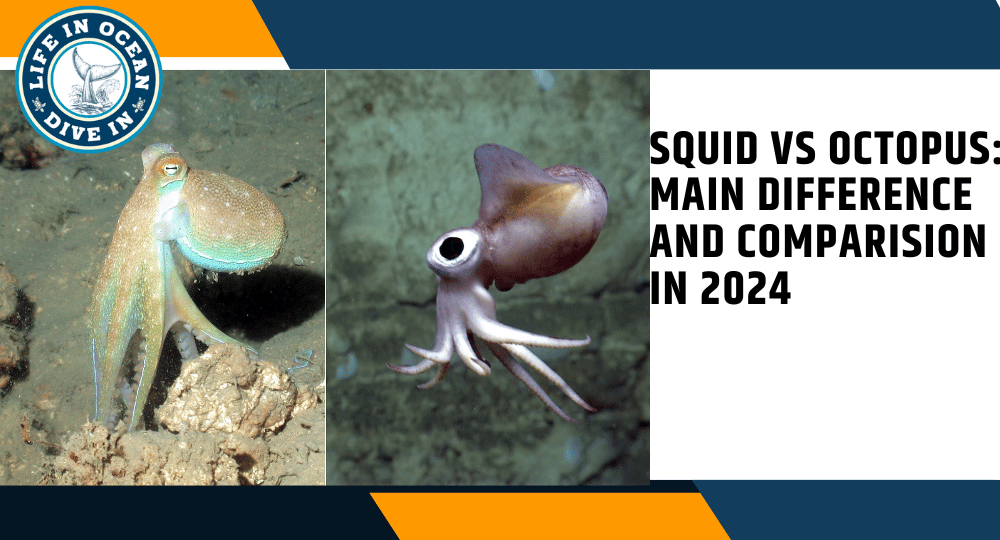
Not only do octopuses change color, but they can also modify the texture of their skin through muscle contractions. By manipulating bumps and ridges on their bodies, they can mimic various objects like coral branches or even poisonous sea creatures as a means of self-defense.
Moreover, octopuses possess an incredible talent for altering their body shape. They can elongate or flatten themselves to resemble different objects or squeeze into tight crevices where predators cannot reach them.
Evading Predators with Unique Defense Mechanisms
Both squid and octopus employ distinct defense mechanisms that help them evade predators and survive in the vast ocean. While squids rely on their ink sacs to create a diversion, octopuses utilize their remarkable camouflage abilities to disappear into their surroundings.
These defense mechanisms not only help these creatures escape danger but also serve as a means of survival in the competitive underwater ecosystem. By effectively evading predators, squids and octopuses increase their chances of living another day and continuing their existence in the mesmerizing depths of the ocean.
Final Thoughts on Squid vs Octopus
And there you have it, the ultimate battle between squid vs octopuses! We’ve explored their habitats, compared their anatomy, discussed their arms/tentacles, delved into their diet and predation habits, examined their reproduction and mating behavior, and marveled at their defense mechanisms and camouflage. But now it’s time to wrap things up.
So what’s the verdict? Well, both squids and octopuses are fascinating creatures with unique qualities that make them masters of the deep sea. It’s like comparing apples to oranges – each has its own distinct flavor. Whether you’re captivated by the squid’s lightning-fast speed or the octopus’s incredible intelligence, one thing is for sure: these cephalopods are truly remarkable.
Now that you know more about these mysterious creatures of the deep, why not take a dive into further exploration? Dive deeper into the world of marine biology or plan an exciting underwater adventure to witness these incredible creatures firsthand. Remember, our oceans are teeming with wonders waiting to be discovered – so grab your snorkel or scuba gear and embark on your own underwater expedition!
So go ahead, embrace your curiosity and let it lead you to new depths. Who knows what other awe-inspiring marvels await beneath the waves? Happy exploring!
FAQs
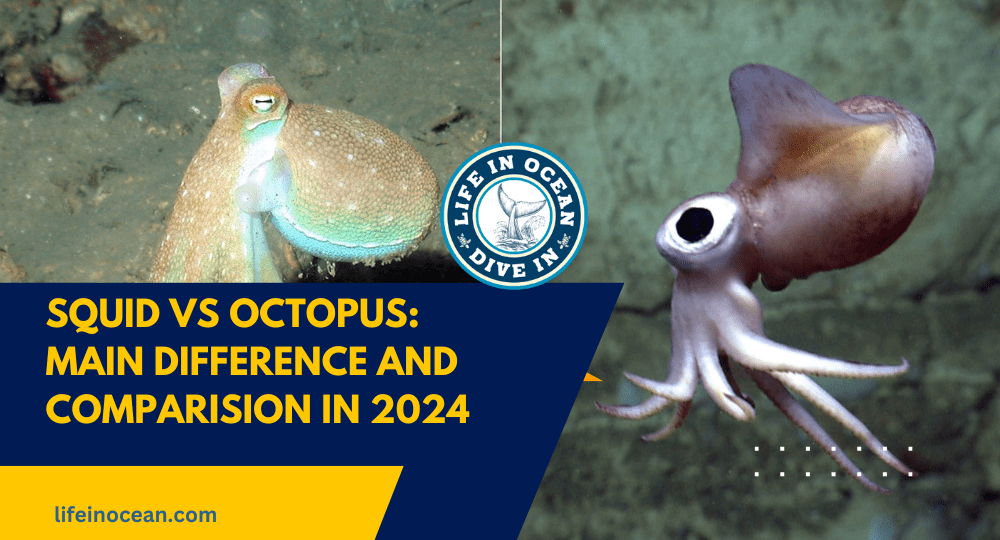
FAQ 1: What is the difference between a squid and an octopus?
Squid and octopus may seem similar, but they have some key differences. Squid have elongated bodies with triangular fins, while octopuses have rounded bodies with no fins. The common octopus, similar to squid, also possess ten tentacles, two of which are longer and equipped with suckers for capturing prey. On the other hand, octopuses have eight arms lined with suckers. Squids tend to be more active swimmers compared to octopuses.
FAQ 2: Are squids and octopuses edible?
Absolutely! Both squids and octopuses are enjoyed as delicacies in various cuisines around the world. From calamari rings made from squid to grilled or fried octopus dishes, these creatures offer unique flavors and textures that seafood enthusiasts love. So why not give them a try? Explore different recipes and savor their delectable taste!
FAQ 3: Can squids or octopuses change color like in movies?
Yes, they can! Both squids and octopuses possess specialized skin cells called chromatophores that allow them to change color rapidly. This ability helps them camouflage themselves in their surroundings or communicate with other members of their species. It’s like having a built-in invisibility cloak or mood ring! It’s truly fascinating to witness these creatures transform before your eyes.
FAQ 4: Are squids and octopuses intelligent creatures?
Absolutely! Squids and octopuses are known for their remarkable intelligence within the animal kingdom. Octopuses, in particular, exhibit problem-solving skills, use tools, escape from enclosures, mimic other animals’ behaviors, and even display playful behavior at times. Their advanced cognitive abilities make them captivating subjects for scientific research and observation.
FAQ 5: Do squids or octopuses pose any dangers to humans?
While squids and octopuses are generally harmless to humans, there are a few species that may exhibit aggressive behavior if provoked or threatened. It’s important to respect these creatures’ space and avoid disturbing them in their natural habitats. However, There’s no need to worry! Just make sure they’re properly prepared and cooked for a safe and enjoyable dining experience.
FAQ 6: Are squids and octopuses related to each other?
Yes, they belong to the same biological class called Cephalopoda, which includes various marine animals like cuttlefish as well. Despite their differences, squids and octopuses share a common ancestry and possess similar characteristics such as soft bodies, tentacles/arms with suckers, excellent maneuverability in water, and advanced nervous systems. Their fascinating evolutionary journey has led them down distinct paths while maintaining some fundamental similarities.
FAQ 7: Can I keep a squid or octopus as a pet?
Keeping squids or octopuses as pets can be quite challenging due to their specific requirements for habitat, diet, and overall care. Most species need large tanks with appropriate filtration systems, ample hiding spots, precise water parameters (temperature, salinity), and specialized diets. Moreover, certain species have short lifespans or complex mating behaviors that make them unsuitable for captivity. Therefore, it’s best to appreciate these incredible creatures in their natural environments rather than attempting to keep them as pets.
Ready to dive deeper into the mysterious world of cephalopods? Let’s explore the octopus vs squid rivalry, including the squid vs octopus fight and the intelligence of these creatures. We’ll also take a closer look at the bigfin reef squid. Explore our blog for more intriguing articles on marine life! Don’t miss out on fascinating facts about these captivating creatures!




